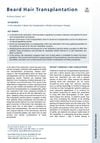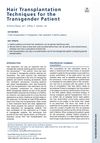Gender-Affirming Hair Procedures
January 2023
in “
Operative Techniques in Otolaryngology-Head and Neck Surgery
”
hair transplantation hairline lowering hairline feminization eyebrow transplantation pubic hair transplantation beard transplantation body hair transplantation male pattern baldness testosterone dihydrotestosterone hairline lowering surgery eyebrow restoration hair transplants hair restoration surgery beard restoration chest hair restoration pubic hair restoration graft placement hair transplant hairline surgery eyebrow transplant pubic hair transplant beard transplant body hair transplant baldness DHT hair surgery chest hair transplant

TLDR Hair transplants help transgender patients look more like their gender identity, with different procedures for trans women and men.
The document discusses the importance of hair transplantation in gender-affirming procedures for transgender patients. For male to female transition patients, hairline lowering, hairline feminization, and eyebrow and pubic hair transplantation are beneficial. For female to male transition patients, beard and body hair transplantation are integral. The most common procedure is feminization of the hairline in trans female patients through transplantation. The progression of male pattern baldness can be reversed through blocking the effects of testosterone and dihydrotestosterone, and applying surgical techniques to restore hair. Hairline lowering surgery can provide immediate results and high hair density, with a single procedure equivalent to 3500 to 7000 grafts. Eyebrow restoration can be achieved through hair transplants, typically involving 200 to 375 grafts per side. For trans male patients, hair restoration surgery can create more masculine features, including restoration of the beard and chest. Beard restoration requires a large number of grafts (2200 or more) and may require a secondary procedure for further density. Chest and pubic hair restoration can help conceal scars from prior surgeries. The document also details the surgical procedures, including anesthesia, graft placement, and postoperative care.




